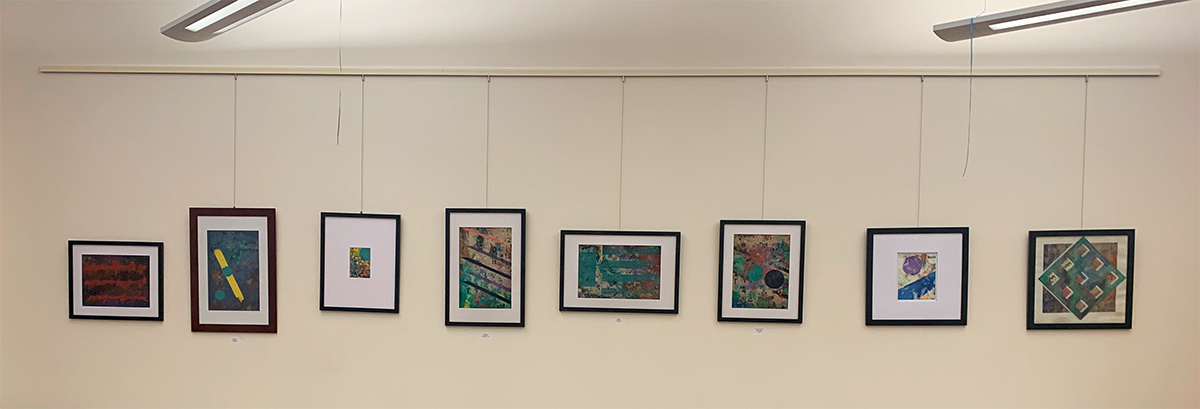Elemental: Earth, Fire, Water, Air 2021
Visual Realia was pleased to have a print in the juried Maryland Federation of Art online "Elemental: Earth, Fire, Water, Air 2021" exhibit.
“Shattered Earth”
Clay Monoprint Workshop — November 2021
Andrew Smith is offering a one-session clay monoprint workshop at the Adams County Arts Council in Gettysburg, Pennsylvania, on Wednesday, November 10th, from 1-4 PM. Participants will use printmaking techniques with colored clay slips to create vibrant monoprints. Basic techniques will be introduced, followed by an open studio format where artists can explore and create their own works. Everyone will leave with two completed prints.
Questions may be directed to Andy at ostman4200@comcast.net. Registration information is available at:
https://www.adamsarts.org/portfolio-item/printmaking-with-clay/
"Pigment" Reception & Exhibit Extension
Andrew Smith’s (Visual Realia) “Pigment” exhibit is extended through August.
The “Pigment” exhibit of clay monoprints by Andrew Smith of Visual Realia has been extended through August and refreshed. The exhibit for the month has twenty-six works, with seven prints new to the Gallery display.
The exhibit can be seen during the Adams County Arts Council’s regular hours, or by contacting Andy for after-hours access. In addition, the exhibit will be part of the Arts Council’s First Friday reception, running from 5-7:30 PM on Friday, August 6th. Andy will be present and will have the clay matrix used for the prints in the gallery. Questions are welcome!
The Adams County Arts Council is located at 125 South Washington Street, Gettysburg, Pennsylvania.
Clay Slip for the Clay Monoprint Artist
The clay monoprint artist must make their own clay slips for their works.
While most painters at this point in time purchase their paints, clay monoprint artists must make their own clay slips, with as many varieties needed as the colors they choose to use in their works.
An immersion or “stick” blender is a worthwhile tool for creating the clay monoprint slips.
#6 tile Kaolin (or China) clay is mixed with water to make the clay slips, roughly to a consistency a little thicker than household paint. (The use of a marshmallow fluff container is optional!)
The artist then mixes in a pigment for each color they wish to use. In the Visual Realia studio, liquid universal pigments are my most common choice, but other materials such as iron oxides are another choice. The amount of pigment added will influence the boldness of the slip.
Want to learn more about clay monoprints? Check out these links:
https://www.visualrealia.com/articles/2017/10/15/art-of-the-clay-monoprint
https://www.visualrealia.com/articles/2019/12/21/evolution-of-a-clay-monoprint-matrix
https://www.visualrealia.com/articles/2021/3/7/from-one-monoprint-to-the-next
And a video here:
https://www.visualrealia.com/articles/2020/5/8/clay-monoprint-technique-demo-video
Interested in learning in person? Contact me for some options.
Universal pigments are a great choice for clay monoprint artists, and come in a wide range of colors.
Visual Realia "Pigment" Exhibit Running
The "Pigment" exhibit continues at the Adams County Arts Council. The Gallery may be in use at times during the day but ask at the front desk if you can view the exhibit.
Feel free to contact me to arrange a visit during an evening or weekend. I'd be happy to meet you there and answer any questions.
Eight of the thirty works have sold, so this is the last chance to see some of these works.
"Under the Ridge" Up for Auction
“Under the Ridge” by Andrew Smith of Visual Realia
In 2018, Hanover Against Hunger packed close to 120,000 meals to be distributed worldwide where needed. This amazing local group raises funds for the project locally, including a silent auction of fourteen artworks.
My entry is "Under the Ridge," a 24" x 20" look down toward the town of Gettysburg from Seminary Ridge. (The building shown is part of the United Lutheran Seminary.)
To bid on the work or see the others available via auction, visit:
https://hanoverareaarts.com/auction-gallery/
You may also view the works in person at the Hanover Area Arts Guild, located at 32 Carlisle Street, Hanover.
To learn more about Hanover Against Hunger, visit their website at:
https://hanoveragainsthunger.org
It's a wonderful organization with an impressive reach. Volunteer or place a bid!














